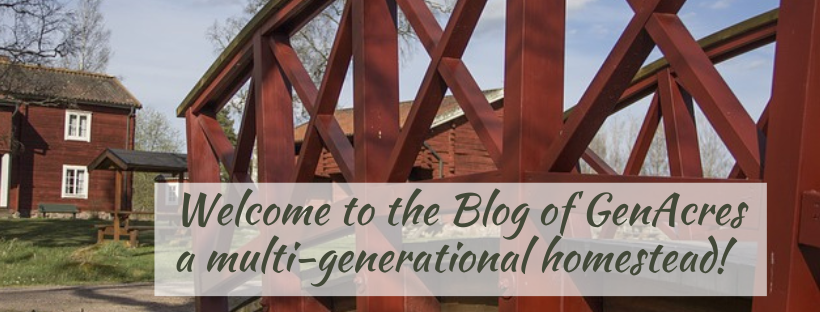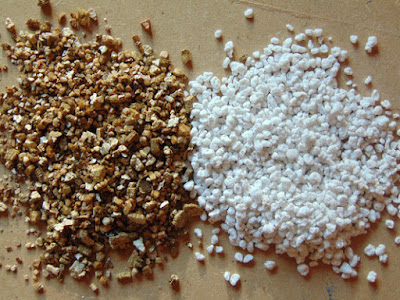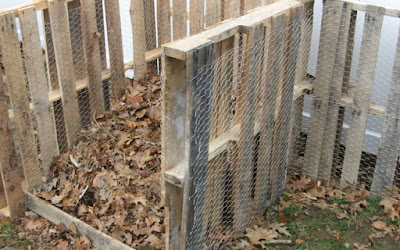Make your own Potting Soil
and Save Money!
Although commercial bagged potting soils have the advantage of being convenient and disease-free, the expense of it alone, especially for a large garden, can make learning to make your own potting mix a very valuable endeavor.
But ask five gardeners for their go-to potting mix recipe and you'll get far more than five answers.
At the end of this article, you will find several suggestions for great potting mixes that you can skip right to.
The advantages of making your own potting soil:
- Convenience. You can mix just the amount you want or need.
- Most commercial bagged potting soil mixes contain a lot of cheap pine bark which will decompose and become moisture resistant. The ingredients you can use will make the mix hold up longer.
- You'll know what ingredients are in it.
- Save money! Although you'll need to buy the separate ingredients for your mix, in the long run, it's cheaper, especially if you have a large garden and buy the ingredients in bulk.
- You can fashion a soil mix especially suited to the plants you're growing.
Good Healthy Potting Soil Must Be:
- Free of weeds and disease.
- Aerated so the plants can get oxygen from the soil.
- Light enough to allow water (and the air) to flow through the soil easily, yet be firm enough to support the plant.
- Be able to retain the water without draining through too fast.
- Be able to retain the nutrients that you add.
There are many ingredients to choose from which can serve to make the process a bit daunting. However, learning the basics will go a long way in easing your concerns.
Types of soil amendments and what they do.
Garden Soil (Not Top Soil)
Garden soil refers to the loamy soils sold in most garden centers. It is mixed to incorporate a variety of soils and textures and usually targets right on the label a certain type of garden or plant.
Advantages:
- It's sterile, so you can avoid disease, insects and weed problems.
- It's a far better choice for potting soil recipes over Top Soil because Garden Soil is made to mix with fertilizer and organic matter where Top Soil is not.
Side Note
Never add soil from your garden. It is un-sterilized and may harbor disease, insects and weed seeds which can cause future problems such as dead, deformed or stunted seedlings or plants.
Compost
A mixture that consists of various decayed plants and vegetative waste is added to the soil to help plants grow.
Advantages:
- It will suppress disease.
- It provides moisture and plant food.
- It improves the structure of the soil.
- It adds several macro and micronutrients to the soil along with several trace elements.
- The compost will be more alkaline and is the better choice instead of Peat Moss for Boxwoods, Hydrangeas, Lavender, and Thyme.
The “Peats”
Coconut Peat, Peat Moss, and Sphagnum Peat Moss
These are types of Peat generally added to potting soils.
Advantages:
- Peats are highly absorbent material.
- Peats are a sterile medium.
- Each type of Peat is listed below with the advantages and disadvantages of each.
Coconut Peat
This is a by-product of the coconut processing industry. It's the finer product that's left behind in processing.
Advantages:
- Coconut Peat doesn't break down as quickly as Peat Moss does.
- It's a renewable resource, unlike Peat Moss.
- It lasts much longer in your soil than Peat Moss.
- It has a more neutral pH than Peat Moss and is good for flowering and fruiting plants that prefer a neutral pH.
Peat Moss and Sphagnum Peat Moss
These are the dead fibrous materials that form when mosses and other living material decompose in peat bogs. Both come in convenient dry, light-weight compact blocks and can be found at garden centers.
Advantages:
- It has an acid pH and is ideal for acid-loving plants such as blueberries, camellias, hostas, etc.
Disadvantages:
- It is composed mostly of moss, and since the process of decomposition is so slow, it is not considered a renewable resource.
- It tends to become water repellent as its moisture content drops to below 30%.
Vermiculite and Perlite
These filler materials are frequently added to potting soils for their ability to lighten and aerate the soil.
Perlite
Perlite is the round white styrofoam-looking specks you see in potting soil.
Advantages:
- It helps to aerate the soil.
- It aids in water retention.
Disadvantages:
- It has a tendency to float to the top of the medium when watered.
- Perlite dust is harmful if inhaled and should be moistened before you mix it in. A mask is also recommended when using it.
Vermiculite
Vermiculite is the sparking particles that you often see in potting mixes. It is a natural volcanic mineral that has been expanded with heat to increase its water-holding capacity.
Advantages:
- It is more superior than Perlite for water retention. The particles soak up the moisture and nutrients and keep them in the mix so the plants can access them.
- It's a permanent ingredient that won't deteriorate or lose volume in the mix.
- It is also sterile and will not become moldy or rot.
Disadvantage:
Sand Coarse or Builder's Sand
A primary ingredient in potting mixes.
Advantages:
Disadvantages:
- It does not improve water-holding capacity.
- Too much sand will make the mix too heavy.
Leaf Mold
Simply, leaf mold is decomposed leaves used to condition the soil. The end result will be dark brown and crumbly.
Advantages:
- It's easier to make than compost. Just pile the leaves up and let them decompose. No mixing browns and greens.
- It increases water retention. It has been known to hold up to 400% of its own weight in water.
- It keeps down the weeds when used as a mulch.
- It provides a great habitat for soil life including earthworms and beneficial bacteria.
- It will lighten up clay soil.
- It will help prevent sandy soils from drying out too fast.
- It's a free, renewable resource!
Ready to mix some soil?
First, here are a few tips:
- Wear a dust mask and gloves when mixing.
- Wash and dry your hands thoroughly afterward.
- Wet down the mix when it's too dusty.
- Presoak Coir Peat or Peat Moss before mixing.
Now for the Recipes!
Note: A “part” can be anything; a scoop, a large cup, a bucket, wheel barrel, etc.
Recipe 1
Soil-Based Potting Mix RecipeFor plants like Hostas and Blueberries that prefer a more acid soil.
1 part Garden Soil1 part moist Peat Moss (For acidity)1 part Perlite or Vermiculite or a combination.
Adjust the texture to create a loose, well-draining mixture. If the mix feels too sandy, add more peat moss. If the mix feels too sticky, add more sand and peat moss.
Add your choice of fertilizer depending on what kind of plants you're growing.
Recipe 2
Soil-Based Potting Mix RecipeFor plants that prefer more alkaline soil.
2 parts Coconut Coir (Neutral pH)1 part finished, sifted compost (Alkaline)1 part Perlite or Vermiculite or a combination.
Add your choice of fertilizer depending on what kind of plants you're growing.
You can add small amounts of leaf mold and humus to the above recipes.
Recipe for Seed Germination
These next two recipes can be used for seed germination because they are relatively sterile, light in texture, weight, and uniformity. The light texture enables seeds to readily germinate and emerge and allows tender roots to grow. It also makes transplanting seedlings easier.
The following recipes are mostly used for seeding and some specific plants like Orchids and Cacti. They are composed of a variety of organic and inorganic materials. They contain mostly peat, bark, pumice-type material or a peat substitute like coconut husks. They do not include soil or have any soil properties. Its lighter weight allows water and nutrients to evaporate or drain the mix.
Recipe 3
Soil-less Potting MixFor seedlings and seeding
1 Part moist Peat Moss or Coconut Coir1 Part Coarse Sand1 part Perlite or Vermiculite or a combination
Moisten and use in flats.
If too sandy, add more peat. If it feels sticky, add more sand.
Fertilizer is usually not added to the mix until the seedlings are healthy and viable, and then at reduced strength.
Recipe 4
2 parts Peat Moss or Coconut Coir
2 parts Vermiculite or Perlite or a combinationMoisten and use in flats.
~~~~~~~~~~
Now that you have a basic knowledge of what's needed in your homemade potting soil mixes, you can adjust and change the mix as needed, depending on what you want to grow.
Good luck and happy planting!
~~~~~~~~~~
Where to go next!
Love hostas or know someone who does?Visit our website for great hostas at an affordable price!
SunsetHostaFarm.com





















This comment has been removed by a blog administrator.
ReplyDelete